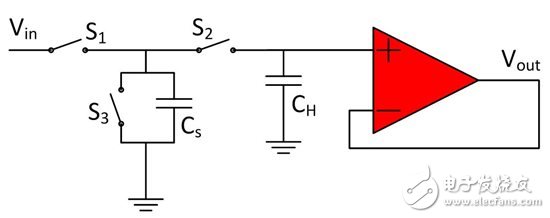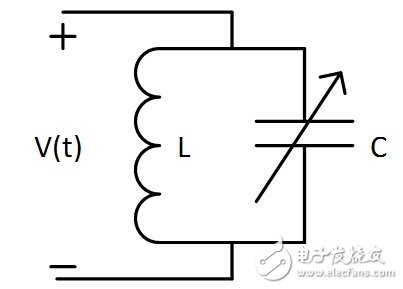Capacitive sensing has been used in many applications, from proximity detection and gesture recognition to liquid level sensing. Regardless of the application, the decisive factor in capacitive sensing is the ability to sense changes in sensor capacitance based on a specific reference. Depending on the specific application and system requirements, you may need different methods to measure this change.
In this blog post, I will introduce two specific architecture types—switched capacitor circuits and inductor-capacitor LC resonant tanks—that are currently used for capacitive sensing circuits.
Switched capacitor circuit
Figure 1 shows a simplified circuit for capacitive sensing that is based on charge transfer; the switches in the circuit perform sample-and-hold operation. Between samples, the change in the charge on the sensor inductor causes a change in the output voltage, and then the change in capacitance can be determined by measuring the amount of change in the voltage.

Figure 1: Schematic diagram of a simplified switched-capacitor circuit that supports sample-and-hold
To sample the charge on the sensor, the sensor capacitor, CS, is fully charged by closing switch S1 and turning on switches S2 and S3. Once CS is full, S1 and S3 will open and S2 will close. This causes the accumulated charge on the sensor capacitor to be transferred directly to the holding capacitor, CH. Once CH is full, S1 and S2 will open, and S3 will close. This will inevitably isolate the discharge of the sensor capacitor (preparing for the next sample) from the buffering of the output voltage potential (stabilized by the CH).
This is a widely used architecture for capacitive sensing. The reason is that this architecture is operated by switches, so its sampling state and hold state are all decoupled. However, this technology also has some shortcomings, that is, it is more susceptible to noise. Due to the broadband characteristics of this sensor, noise from external sources of interference—even if the operating frequency of this source is different from the operating frequency—is still problematic. You may need an external circuit for filtering, which will increase the complexity of the system and may reduce the sensitivity when the filter introduces significant parasitic capacitance. However, if the system is not exposed to broadband noise, this architecture may be sufficient.
LC resonant tank
The LC resonator shown in Figure 2 is another sensor architecture used in capacitive sensing. Equation 1 determines the oscillation frequency of the LC tank circuit.

Figure 2: Schematic of a simple LC resonant tank circuit

(1)
Looking at Equation 1, it is clear that the oscillation frequency depends only on the total inductance and total capacitance of the resonant tank. Therefore, if the purpose of capacitive sensing is to measure the change in capacitance value, the total inductance of the resonant tank circuit is fixed, and the capacitive component of the resonator forms the sensor. Since the capacitance value changes as the sensor responds to the target, the oscillation frequency will change. Then, the change in the resonant tank frequency becomes your measurement to determine the measured change in capacitance.

Figure 3: LC resonator characteristics
Although the architecture of the LC resonant tank is simple, several major advantages of this circuit make it a relatively new approach in the field of capacitive sensing. First, an LC resonator provides excellent electromagnetic interference (EMI) immunity due to its inherent narrow-band characteristics (as shown in Figure 3). In addition, if noise sources do exist at any known frequency, it is possible to filter these noise sources by moving the sensor's operating frequency without using external filters. This will help increase the sensitivity of the system (if the application requires high sensitivity) and reduce its complexity.
This scratch-resistant TPU Film protects your new AirTag from daily wear and tear. It can be easily glued to the back to keep the shiny silver in its original condition. In addition, the AirTag screen protector with "self-healing" function can automatically repair small scratches and bubbles within 24 hours. This means you can continuously enjoy the new look and appearance of AirTag without worrying about serious scratches and dents.
The Apple Airtag TPU Film can perfectly fit your AirTag skin. It is designed to provide the maximum coverage for your AirTag metal panels. Compatible with most AirTag shells. Leave extra space around the frame so that your shell can wrap the edges of the AirTag without interfering with the film.
The 0.14mm ultra-thin AirTag Screen Protector allows you to enjoy the maximum resolution while being thin enough to make the AirTag sensitive to the original signal response, ensuring that it will not affect any user experience. You won't even notice that the screen protector is there, so your Apple logo can still be displayed.
The AirTag Tracker Screen Protector is very easy to apply and is specially designed for your AirTag. Just clean your AirTag and install it on the surface to eliminate all bubbles and get the job done!
Apple Airtag Screen Protector, Apple Airtag Screen Protective Film, Apple Airtag TPU Film, AirTag Tracker Screen Protector, Skin Wrap
Shenzhen Jianjiantong Technology Co., Ltd. , https://www.hydrogelprotectivefilm.com